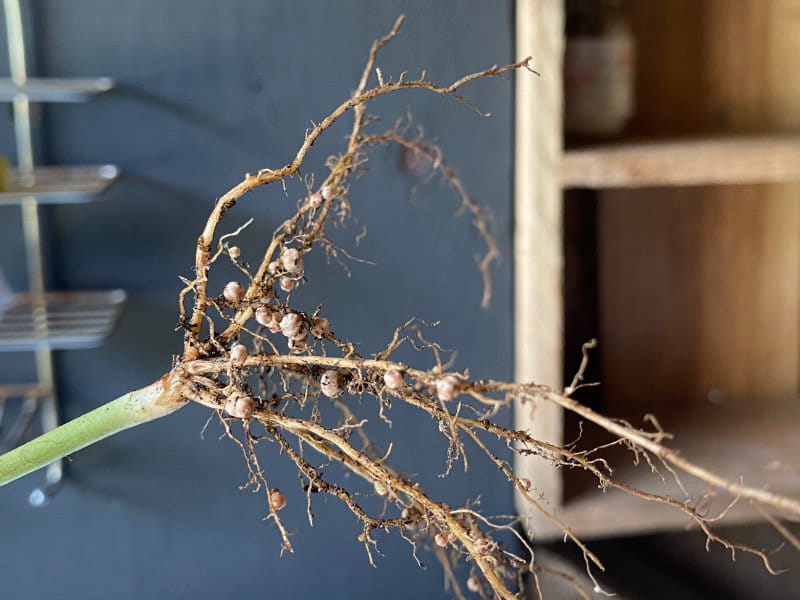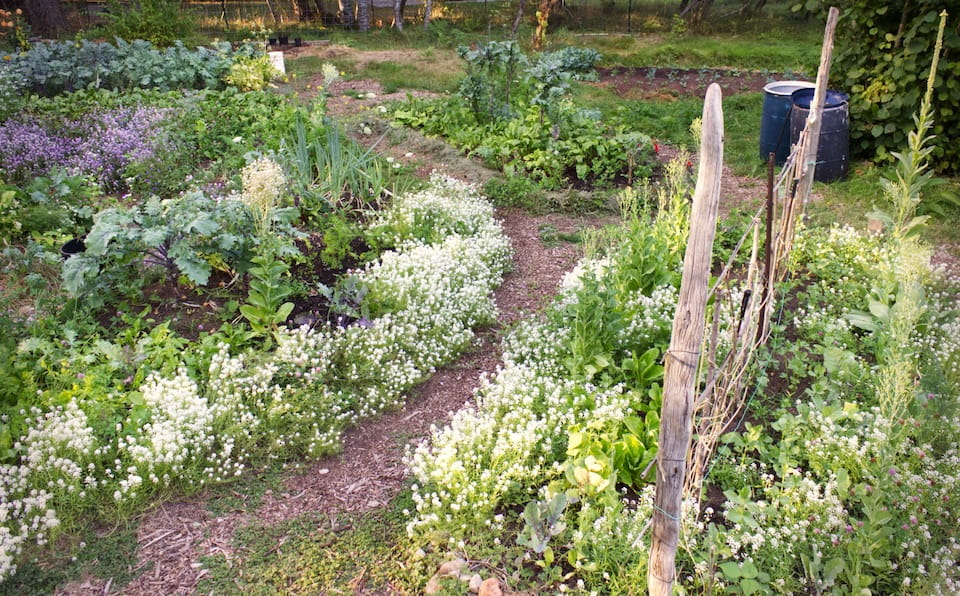Green manures are a selection of fast growing plants commonly used in agricultural rotations to prevent soil erosion, enhance soil health and improve crop yields.1 Regular crops deplete soil nutrients which green manures help replenish through nitrogen fixation and/or the addition of organic matter. They are grown specifically to be incorporated back into the soil at the end of their growth cycle rather than being harvested.
Most often cut before blooming and setting seed, green manure’s decomposing biomass feeds beneficial microorganisms. Over time this greatly enhances soil structure, promotes nutrient retention and increases water infiltration.
Green manures tend to be part of the legume (Fabaceae) family. This includes clovers, vetches, cowpeas, soybeans, and alfalfa. These plants fix nitrogen in the soil through the rhizobium bacteria living in their root nodules.
Non-legume plants such as grasses (rye, oats), buckwheat and mustard are also commonly used. While they don’t fix nitrogen, they help improve soil structure, add organic matter, and can suppress weeds or pests. They are often used in combination with legumes.
Because of their rapid growth, green manures not only suppresses weeds but their roots can open up heavy soils for better drainage. Plants such as phacelia and buckwheat are also known for attracting beneficial insects, and they provide shelter for predators such as frogs and beetles. 2

Are Green Manures the same as cover crops?
The main difference between green manures and cover crops lies in their emphasis and timing. Within agriculture, cover crops are grown between cash crops primarily to protect the soil from erosion during the winter months. Green manures in contrast are grown during the main growing season in place of a cash crop with focus on adding organic matter and nutrients to the soil. Both green manures and cover crops contribute to soil health by preventing erosion, adding organic matter, attracting beneficial insects, and improving soil quality. The distinction between the two practices is primarily based on when grown and what are the specific goals.3
For the market or home gardener, green manures are less used due to space restrictions. On a small allotment, home gardeners are rarely able to tie up a whole bed during a prime growing season. For a severely depleted bed, however, it may be worth giving up that space for a short period.
Common Green Manures and Their Soil Enrichment Purposes:
Legumes (e.g., vetch, clover, beans, peas): Leguminous roots develop nodules in symbiosis with the nitrogen-fixing rhizobium bacteria. This enhances soil fertility for subsequent crops.3
Grasses (e.g., annual ryegrass, oats, winter wheat, winter rye): These quick growing grasses smother weeds, prevent erosion and reduce compaction. Incorporated into the soil, it enhances its structure while decaying biomass restores nutrients to the soil.4
Brassica Species (e.g., Rapeseed, Mustard, Radish and Turnip): Brassicas add organic matter to the soil. The fibrous root systems of rapeseed and mustard help improve soil structure by binding soil particles together into aggregates. This enhances soil tilth, porosity and water holding capacity. Radishes and turnips scavenge excess nutrients in the soil from previous crops. This prevents nutrient leaching . Upon decomposition these plants recycle them into the soil. Brassicas also have taproots that can penetrate up to six feet into the soil, which can alleviate compaction and improve water infiltration. This deep rooting ability enhances nutrient scavenging from deeper soil layers. Brassicas that winterkill decompose rapidly, leaving behind a seedbed that is easy to plant in for subsequent crops.5
Buckwheat: Buckwheat is known for its fast growth and weed suppression qualities, making it a beneficial green manure choice to improve soil health and structure. It also attracts beneficial pollinators.
Phacelia: Phacelia does not fix atmospheric nitrogen like legumes, but it is an excellent nitrogen holder or “catcher crop”. Its dense root system helps prevent nitrogen from leaching out of the soil during fallow periods. A quick growing plant, Phacelia can provide soil coverage in 6 to 8 weeks. Its extensive fibrous root system helps improve soil structure and drainage when the plants are incorporated into the soil. If left to bloom, the purple/blue flowers of phacelia are very attractive to bees, hoverflies, and other beneficial insects that aid in pollination. This can boost yields of subsequent crops.6
Example of a Small Garden Combination:
If you have limited space and can only choose three green manure crops, I’d recommend selecting ones that can be grown in different seasons. This allows you to make the most of your limited space throughout the year. The following example of three green manure crops demonstrates a range of benefits, including weed suppression, soil structure improvement, and nutrient enhancement.7
- Spring or fall: Crimson clover (Trifolium incarnatum) is is a cool-season annual and nitrogen-fixing legume. It can be planted in the fall or early spring. In addition to its nitrogen-fixing abilities, crimson clover provides good ground cover, suppresses weeds, and attracts beneficial insects. It’s also relatively easy to cut down and incorporate into the soil before it sets seed.
- Late spring or summer: Buckwheat (Fagopyrum esculentum) is a fast-growing, warm-season annual typically sown in spring or summer. It’s excellent for quickly suppressing weeds, improving soil structure, and attracting beneficial insects, both pollinators and predators. Buckwheat is also a good choice for gardeners with poor soil, as it can grow in low-fertility conditions and doesn’t require much water. It decomposes quickly, making it easy to incorporate into the soil.
- Fall: Winter rye (Secale cereale) is a hardy, cool-season grass that planted in the fall can grow over the winter months. It is a good choice for preventing soil erosion while suppressing weeds and improving overall soil structure. Winter rye produces an extensive root system that helps break up compacted soil and scavenge nutrients. It can be challenging to incorporate into the soil due to its tough fibers. Cutting it down while still young and tender can make the process more manageable.
Considerations
While green manures offer many benefits, there are also some potential drawbacks to consider:
- Time and effort: Growing and incorporating green manures requires more time and effort compared to leaving garden beds fallow.
- Temporary nutrient lock-up: This is essential to be aware of within crop rotations. As green manures decompose, they can temporarily tie up nutrients like nitrogen in the soil. For a short period this can make it unavailable to other near by plants.
- Seed production and weediness: If you don’t cut down and incorporate green manures before they set seed, they can spread throughout your garden. Species like clover can be difficult to remove once established.
- Allelopathy: Some green manure crops, such as mustard and rye, produce chemicals that can inhibit the growth of other plants. While beneficial for weed suppression, it can also negatively impact nearby or subsequent crops if not managed.
- Water competition: In dry climates or during a drought, green manures can compete for water with other plants. They may demand additional irrigation.
- Potential pests and diseases: It’s essential to choose green manure crops that are resistant to common pests and diseases in your region.
- Reduced space for food production: Using green manures means dedicating garden space to a non-food crop for a portion of the growing season. This may not be ideal for gardeners with limited space or those who want to maximize food production.
To mitigate these drawbacks, carefully select green manure crops based on your garden’s needs, climate, and available space. Properly managed, cutting them down before they set seed, and incorporating them into the soil at the right time, green manures can go a long way towards maintaining soil health and balance.8

How to use green manures:
- Choose the right green manure: Select green manure crops based on your garden’s needs and your local climate. Some popular options include clover, buckwheat, winter rye, and field peas. Legumes like clover and field peas fix nitrogen in the soil, while buckwheat and winter rye are excellent for weed suppression and improving soil structure.
- Plant at the right time: Timing is crucial for maximizing the benefits of green manures. Plant them during the off-season when your garden beds are otherwise empty. This is using them as a cover crop. For example, you can plant winter rye in the fall and let it grow over the winter months. Buckwheat planted in the summer can provide quick ground cover and attract beneficial insects.
- Prepare the soil: Before planting green manure, clear any debris, weeds, and loosen the soil with a garden fork.
- Sow seeds evenly: Broadcast green manure seeds evenly across the garden bed ensures good coverage and prevents competition between plants. Follow the seed packet instructions for planting depth and spacing.
- Water and care for the green manure: While fairly low maintenance, green manures need to be well-watered and free of weeds to establish quickly and provide the maximum soil benefits.
- Chop and incorporate: Before the green manure crop sets seed, cut it down and chop it into smaller pieces. This will make it easier to incorporate into the soil. You can use a garden fork, tiller, or even a lawnmower to chop the plants.
- Dig the plants and foilage into the top 25 cm of the soil.
- Allow time for decomposition: After incorporation into the soil wait at least 2-4 weeks before planting your next crop. This will give the green manure time to decompose and release its nutrients into the soil.
- Rotate green manure crops: To maintain soil health and prevent the buildup of pests and diseases, rotate green manure crops each season. This will also help you take advantage of the different benefits that each type of green manure offers.
- Combine with other soil-improving practices: Green manures are just one part of a healthy garden ecosystem. Combine their use with other practices like composting, mulching, and cover cropping to further improve your soil.
- Have patience: Improving soil health with green manures takes time. The long-term benefits are worth the effort, producing healthy plants, fewer pests and diseases, and a more productive garden.
- https://www.usda.gov/media/blog/2020/01/14/rediscovering-cover-crops-and-power-green-manure
- https://open.alberta.ca/dataset/d4288952-e012-4c26-b886-6395f16c6027/resource/cfe4f490-3db5-4aad-af53-ef726beac19f/download/legume-green-manuring.pdf
- https://utia.tennessee.edu/publications/wp-content/uploads/sites/269/2023/10/W235-G.pdf
- https://www.thespruce.com/what-is-green-manure-1761842
- https://ag.umass.edu/vegetable/fact-sheets/cover-crops-brassicas
- https://www.greenmanure.co.uk/products/phacelia-green-manure-seeds?variant=1182263188
- https://valleytable.com/cover-crops-and-green-manure/
- https://www.daera-ni.gov.uk/articles/green-manures

